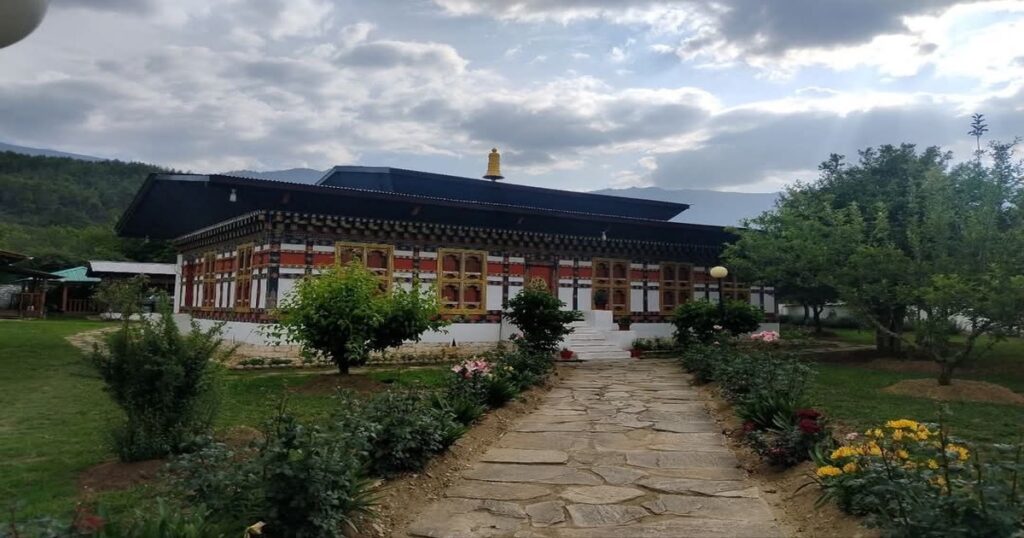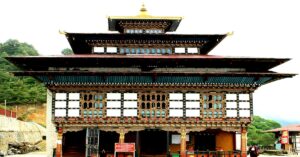Kyichu Lhakhang is one of the oldest temples in Bhutan, built by Songtsen Gampo in 659 CE. It was built as part of the 108 temples constructed in a single day to pin down an ogress who was opposed to the spread of Buddhism. Paro Kyichu Lhakhang Temple is located in the north of Paro town under Lamgong Gewog of Paro Dzongkhag.
Paro Kyichu Lhakhang is between Tenchen Choeling nunnery, Taktsang, and Sangchoekhor. Today, the temple complex comprises two distinct structures: the Jowo Lhakhang, the older temple, and the Guru Lhakhang, a newer one built in the 19th century.
Among the 108 temples built in the Himalayan region, the well-known ones within Bhutan are the Kyerchu temple in Paro and Jambay Lhakhang in Bumthang. Other lesser-known temples are Lhakhang Karpo and Lhakhang Nagpo in Haa, Kongchogsum in Bumthang, and Khaine in Lhuntse Dzongkhag.
How to Reach Kyichu Lhakhang
Paro Kyichu Lhakhang is en route to Tiger’s Nest Monastery, outside Paro’s main town area. The distance from Paro town to Kyichu Lhakhang is 5 km. You can rent a taxi from Paro to reach Kyichu Lhakhang.
From Paro Town: Kyichu Lhakhang is 4 kilometers (2.5 miles) from Paro Town. A taxi takes under 10 minutes to reach it.
From Paro International Airport: The temple is around 5 kilometers (3 miles) from the airport. A taxi will get you there in about 15 minutes.
Another way to reach Kyichu Lhakhang from Paro is by hiking. It is an hour-long hike. Enjoy a picturesque walk on a more scenic route.
The Kyichu Lhakhang entry fee costs Nu. 500 per person for tourists, while it’s free for the locals. There is a 50% fee exemption for children aged 6 to 18 years, and a full fee exemption for children 5 years and below will remain the status quo.
Also Read: Chimi Lhakhang Hike
Sacred Relics to See at Kyerchu Lhakhang
- 7th-century statue of Jowo Sakyamuni, also known as Jowo Rinpoche;
- Chenrezig statue bearing 11 heads and 1,000 arms;
- Painting of King Gesar of Ling;
- Orange trees that bear fruit all year long;
- Silver Chorten in Guru Lhakhang;
- Guru Rinpoche and Kurukulla statues.
Also Read: Guru Rinpoche in Bhutan: His Visits to Bhutan and Sacred Sites
Historical Significance of Kyichu Lhakhang
When was Kyichu Lhakhang built? Kyichu Lhakhang was built by Songtsen Gampo in 659 CE.
According to Kyichu Lhakhang’s history, when Songtsen Gampo was on a mission to spread Buddhism in the Himalayan region, a demoness lay across Tibet and the Himalayas, preventing the spread of Buddhism in the area. To subdue the demoness and introduce Buddhism, the King was destined to build 108 temples known as Thadrul-Yangdhul (temples on and across the border) in a day, in the 7th century.
To fulfill this destiny, Songtsen Gampo and his two wives constructed 108 temples across the Himalayas in a single day, each of which pinned the demoness. Twelve temples were built to pin down her shoulders and legs. Four additional temples were constructed to secure her hands and feet, four more on her elbows and knees, and four more to pin down her shoulders and hips.
According to Bhutanese legends, the Jowo temple of Lho Kyerchu was built on the left foot, while Jambay Lhakhang was constructed to pin down the demoness’s left knee.
Also Read: Jambay Lhakhang, one of the Oldest Temples in Bhutan, founded in 659 CE
Later, in the 8th century, Guru Rinpoche visited Kyerchu Lhakhang and hid treasures there. The treasures included relics, monuments, and holy teachings.
Kyichu Lhakhang Paro has also been visited and blessed by several well-known Buddhist saints. In the 11th century, Lama Drumpa, a Terton (treasure revealer), came to this place and recited the “wrathful subjugating mantras of the Razor Scriptures.”
The Lhapas looked after the temple during the 12th century, but by the 13th century, a descendant of Nyima, one of the sons of Phajo Drugom Zhigpo, had taken it.
Later, in the 15th century, Pema Lingpa uncovered Kyichu Lhakhang and renovated it. In 1644, Zhabdrung Ngawang Namgyal took control of the temple.
Importance of Kyichu Lhakhang
Kyichu Lhakhang is important as it is one of the country’s oldest temples, built in the 7th century, and was also visited by Guru Rinpoche, who hid treasures in the 8th century.
Kyichu Lhakhang is also important as it was also visited and blessed by numerous prominent Buddhist saints like Lhapa, descendants of Phajo Drugom Zhigpo, Pema Lingpa, and Ngawang Namgyal.
The rulers of Bhutan have also valued and guarded Kyichu Lhakhang over the ages, understanding its great significance.
Description of Lho Kyerchu Lhakhang
When you reach the parking area of Kyichu Lhakhang, there is a ticket counter. Take the right footpath to enter the temple. As you enter the inner courtyard of Kyerchu Lhakhang, you’ll see, to the right of the doorway, a mural of King Gesar of Ling, the popular Tibetan warrior-king, on the wall. Additionally, the courtyard has two orange trees that produce fruit all year round. It is said that Guru Rinpoche planted these trees.
From 1836 to 1838, additional buildings and a golden roof were added by the Penlop (governor) of Paro on the orders of the 25th Je Khenpo Sherub Gyeltshen. He not only added many more statues but also expanded the sanctum of Jowo Lhakhang of Kyerchu. Later, in 1968, Her Majesty Ashi Kesang Choden Wangchuck built a Guru Lhakhang next to the old Jowo Temple.
Kyichu Lhakhang
The Kyichu Lhakhang complex has two temples: the Jowo temple and the Guru Lhakhang.
Jowo Temple
The main entrance door of Jowo Lhakhang is coated with gold. Jowo Jampa or Jowo Sakyamuni, built by King Songtsen Gampo in the 7th century, is the main statue of the Jokhang of Kyichu Lhakhang. The wooden floor in front of the Jowo statue is said to have been worn down due to prostrations by devotees for ages. Nearby, there is a statue of Chenrezig. The Zimchung of Dilgo Khyentse Rinpoche, along with his bed and throne, is still in a room to the left. On the upper floor of the Kyichu temple is a statue of Songtsen Gampo.
Guru Lhakhang
Guru Lhakhang is next to the Jowo temple. It was constructed under the sponsorship of Ashi Kesang Choden Wangchuck in 1968. Dilgo Khyentse consecrated Guru Lhakhang. The main relic of Guru Lhakhang is a 5-meter statue of Guru Rinpoche and Kurukulla (Red Tara) with a bow and arrow made of flowers. On the right side of the statue of Guru Rinpoche is a chorten that holds the ashes of Dilgo Khyentse. A statue of Dilgo Khyentse Rinpoche and some old portraits of Gongsa Ugyen Wangchuck and Ashi Kesang Choden Wangchuck are also present.
Dilgo Khyentse Rinpoche Memorial House

Dilgo Khyentse Rinpoche Memorial House is one of the oldest structures near Kyichu Lhakhang, where Dilgo Khyentse lived in Bhutan. The residence remained empty after Rinpoche’s death in September 1991.
However, in 2010, it was turned into a museum in memory of a great Nyingma master. Since then, the Dilgo Khyentse Rinpoche Memorial House has been open to tourists.
The museum has many intricate statues of Buddha and a lot of paintings portraying the life of Guru Rinpoche. It also houses portraits of Rinpoche, colorful praying wheels on the ground, meditation rooms, a wooden alcove, and his personal belongings like costumes and hats, books, and letters on display. The memorial house also showcases documentaries about Rinpoche’s life.
Kyichu Lhakhang Festival
Every year, the annual ritual, Kyichu Zangchoe Moenlam, or the “Rite of Great Accomplishment,” is performed from the 22nd to 24th day of the 8th month of the Bhutanese calendar for the deities Vajrasattva, Palchen Heruka, and Vajrakilaya for the well-being of the King, country, and people.
Kyichu Lhakhang Timings
The timing of Kyichu Lhakhang is important for visitors who want to see this magnificent old Buddhist monastery. You can visit Kichu Lhakhang throughout the week, but the timing is between 9 a.m. and 12 p.m. and 1 p.m. and 5 p.m.
Best Time to Visit Paro Kyichu Lhakhang
The best times to visit the Paro Kichu temple are spring (March to May) and autumn (September to November). During spring, the weather is pleasant, and the surrounding landscape is lush and green, while the autumn landscape is golden with the ripe paddy fields of Paro Valley. You can visit the major pilgrimage sites of Paro with the Bhutan Pilgrimage Package.
Sacred Places to Explore in Paro
Paro Rinpung Dzong: Also known as Paro Dzong, it is one of the 16 dzongs built by the Zhabdrung Ngawang Namgyal in Bhutan in 1646. It was built as a defensive fortress against the Tibetan invasions. It is one of the biggest dzongs in Bhutan.
Hungrel Dzong: It was a fortress built on the sacred site of Guru Rinpoche. The Dzong was constructed by Drung Drung Gyelchog in the 15th century.
National Museum of Bhutan: It is located just above Paro Rinpung Dzong. The National Museum, housed in a former watchtower, Ta Dzong, showcases a vast collection of ancient Bhutanese artifacts.
Tiger’s Nest Monastery (Taktsang Monastery): The monastery is perched on the edge of a cliff, where Guru Rinpoche came here riding a tigress. It is one of the most sacred sites in Bhutan.
Druk Choeding Lhakhang: Also known as Tshongdoe Naktshang, it is a two-story temple built by Lama Ngawang Chhogyal in Paro in 1525.
Zuri Dzong: One of Bhutan’s oldest and most historically significant fortresses in the sacred site of Namthong Karpo. Built in 1352, it served as a defensive structure against invasions.
Frequently Asked Questions
Who built Kyichu Lhakhang?
The Tibetan King Songtsen Gampo built Kyichu Lhakhang in the 7th century.
Why was Kyichu Lhakhang built?
The Lhakhang was built as part of the 108 temples to pin down an ogress to earth, opposing the spread of Buddhism in 659 CE.
Why is Kyichu Lhakhang important?
Kyichu Lhakhang is important as it is one of the oldest Lhakhangs built in the 7th century. The Lhakhang is also important as it helped spread Buddhism in Bhutan. Guru Rinpoche also visited Kyichu Lhakhang and hid several treasures. Later, many Buddhist saints like Lhapa, descendants of Phajo Drugom Zhigpo, Pema Lingpa, and Ngawang Namgyal blessed the temple.
What is the main statue of Kyichu Lhakhang?
The main statue of Kyichu Lhakhang is the Jowo Jampa.
Can visitors receive blessings or participate in religious rituals at Kyichu Lhakhang?
Yes, visitors are welcome to receive blessings from the main shrine and participate in religious rituals such as making offerings at the shrines, lighting butter lamps, reciting prayers, meditating, and circumambulating the temple.
Enjoyed reading this blog?




